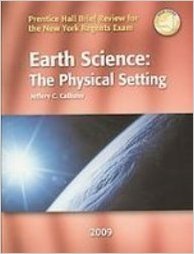
Earth Science: The Physical Setting
1st Edition
ISBN: 9780133200409
Textbook solutions
All Solutions
Page 95: Practice Questions
Exercise 1
Result
1 of 1
2
Exercise 2
Result
1 of 1
4
Exercise 3
Result
1 of 1
1
Exercise 4
Result
1 of 1
1
Exercise 5
Result
1 of 1
2
Exercise 6
Result
1 of 1
3
Exercise 7
Result
1 of 1
3
Exercise 8
Result
1 of 1
1
Exercise 9
Result
1 of 1
2
Exercise 10
Result
1 of 1
3
Exercise 11
Result
1 of 1
3
Exercise 12
Result
1 of 1
1
Exercise 13
Result
1 of 1
1
Exercise 14
Result
1 of 1
2
Exercise 15
Result
1 of 1
4
Exercise 16
Step 1
1 of 2
The graph below shows the plot of the temperature of shiny can (blue dot) and black can (red dot) in degree-Celsius during 0-minute up to 10 minutes in a one-minute interval.

Step 2
2 of 2
The graph shows that the black can absorbs more heat than the shiny can when the lamp was on. When the lamp was turned off, the shiny can gradually decreased in temperature as compared to the black can.
Exercise 17
Result
1 of 1
8 min.
Exercise 18
Result
1 of 1
$rate=dfrac{change;in;temprature}{change;in;time}$
$$
rate=dfrac{32-20}{10}= dfrac{12}{10}=1.2;°C/m
$$
Exercise 19
Result
1 of 1
Radiation process.
Exercise 20
Result
1 of 1
A black can absorbs all wavelengths of light and converts them into heat. a shiny can reflects a huge amount of wavelengths of light, so the can gets warmer.
Exercise 21
Result
1 of 1
Conduction method.
Exercise 22
Result
1 of 1
make the can darker.
Exercise 23
Result
1 of 1
the specific heat of the iron is less than the heat of dry air.
Exercise 24
Step 1
1 of 3
From 13-18 minutes, the black can emitted 1$^circ$C per minute, while the shiny can only emitted 0.5$^circ$C per minute from the 11 to15-minute mark.
Step 2
2 of 3
This shows that the black can releases more heat or energy as compared to the shiny can when the lamp was turned off.
Result
3 of 3
Black can, 13-18 minutes.
Exercise 25
Step 1
1 of 2
The temperature field map below shows the three isotherms – 23$^circ$C, 24$^circ$C, and 25$^circ$C isotherm.


Step 2
2 of 2
The isotherm lines are drawn by connecting the dots of equal temperature values. Every point along the isotherm lines have temperature values that are the same.
Exercise 26
Step 1
1 of 5
On the temperature field map, the distance from point A to B is measured to be 1.8 meters. The temperature in point A is 27$^circ$C while the temperature at point B is 24$^circ$C


Step 2
2 of 5
(a) The equation for gradient is given by:
$$ begin{aligned}
text{gradient} &=frac{text{change in (amount of) field value}}{text{change in distance (horizontal distance}}\
end{aligned} $$
$$ begin{aligned}
text{gradient} &=frac{text{change in (amount of) field value}}{text{change in distance (horizontal distance}}\
end{aligned} $$
Step 3
3 of 5
(b) Plug known values in the equation in (a):
$$ begin{aligned}
text{gradient} &=frac{27^circ text{C}-24^circ text{C} }{1.8 text{ meters}}\
end{aligned} $$
$$ begin{aligned}
text{gradient} &=frac{27^circ text{C}-24^circ text{C} }{1.8 text{ meters}}\
end{aligned} $$
Step 4
4 of 5
(c) The average gradient is given by:
$$ begin{aligned}
text{gradient} &=frac{27^circ text{C}-24^circ text{C} }{1.8 text{ meters}}\
&=frac{3^circ text{C} }{1.8 text{ meters}} \
&=boxed{textbf{$1.7 dfrac{^circ text{C}}{text{meter}}$}}
end{aligned} $$
$$ begin{aligned}
text{gradient} &=frac{27^circ text{C}-24^circ text{C} }{1.8 text{ meters}}\
&=frac{3^circ text{C} }{1.8 text{ meters}} \
&=boxed{textbf{$1.7 dfrac{^circ text{C}}{text{meter}}$}}
end{aligned} $$
Result
5 of 5
$1.7 ^circ text{C per meter}$
Exercise 27
Step 1
1 of 1
A location on the map that would be considered an energy source would be at the highest temperature.


Exercise 28
Step 1
1 of 1
The location in the map that has the least amount of kinetic energy is in the area with lowest temperature.


Exercise 29
Step 1
1 of 2
The decay of radioactive isotopes in the Earth’s core, such as potassium-40 and thorium-232 produces the vast majority of Earth’s heat. The heat from the Earth’s core constantly radiates out to the Earth’s crust and warming rocks, water, gas, and other geological material which results in geothermal energy.
Step 2
2 of 2
The supply of fossil fuel is limited while the geothermal energy from radioactive decay in the Earth’s core will last longer since the Earth will continue to radiate heat out from its core for billions of years.
Exercise 30
Step 1
1 of 2
The nuclear process that results in geothermal energy is radioactive decay. This process is the change of a less stable nucleus to a more stable nucleus. The energy released from the decay results in geothermal energy.
Step 2
2 of 2
The process that produces energy within the sun is nuclear fission. This process is the splitting of one large atomic nucleus into smaller fragments.
Exercise 31
Step 1
1 of 2
The evidence in the Earth Science Reference Tables that suggests the existence of geothermal energy is the Inferred Properties of Earth’s Interior
Result
2 of 2
Inferred Properties of Earth’s Interior
Exercise 32
Step 1
1 of 2
The deposit with all steam would most likely produce the greater amount of geothermal energy than the all hot liquid water deposit since steam is always hotter than boiling water.
Result
2 of 2
All steam will produce greater geothermal energy since it has higher temperature.
Exercise 33
Step 1
1 of 2
The energy generated from hydroelectric facilities rely on the water cycle which is driven by the sun.
Step 2
2 of 2
The falling water from streams and lakes are driven by gravitational energy which drives mechanical devices in hydroelectric facilities to generate electricity.
unlock

